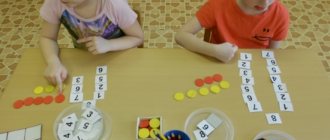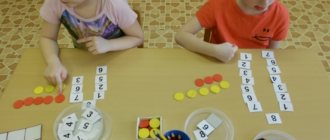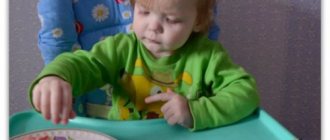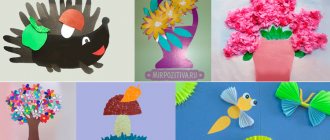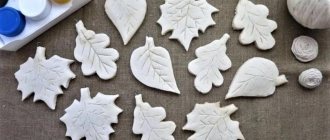What should a 4-5 year old child know in mathematics?
A four to five year old child should:
- Know basic geometric shapes: square, circle, rectangle, oval, triangle.
- Be able to count to ten and recognize numbers from zero to nine by sight.
- Be able to arrange numbers from one to five both in order and in reverse order.
- Find your bearings in the location of objects: where is right, left, top, bottom, front, back.
- Know and distinguish between the time of day and the seasons.
- Learn to write numbers correctly.
- Be able to compare: what is more, what is less, and what is equal.
- Know the meaning of the words: high - low, wide - narrow.
Child practicing in the garden
Important! A child, and especially a preschooler, will perceive the learning process better if it is turned into a children's game. During play, the child is more active, more attentive to the material and more fun.
Methods and frequency of conducting classes with children
There are four methods of teaching preschool children.
One of the common methods of conducting classes is the demonstration method. A methodological technique of the demonstration method is a demonstration. But when displaying, a number of requirements must be met:
- brevity;
- definition;
- expressiveness of speech;
- consistency of actions and words.
Mathematics at preschool educational institutions
Children's imaginative thinking is very developed at the age of 4-5 years, so this method is often used in preschool institutions. This method requires demo material:
- Pictures;
- cards;
- cartoons;
- toys;
- living material: leaves, shells, cones, fruits;
- slides and more.
Additional Information. There are many manuals and literature that can help parents and children learn, for example, authors such as E. Bortnikova, K. Shevelev, L. Peterson, E. Kolesnikova, L. Mavrina, etc. will help young mathematicians better understand the material.
The next method is practical. The only condition is that the child must complete the tasks independently. Thanks to this method, the child will be able to apply the acquired skills in the world around him.
Internal regulations for preschool children in accordance with the Federal State Educational Standard
Verbal methods - no one has canceled a simple explanation to a preschooler. All kinds of conversations, explanations, examples, as well as questions.
The game method is one of the frequently used teaching methods in kindergartens. It was already noted above that with the help of games it is easier for a child to master a difficult topic for him. But this method also forms creative thinking in the child and develops imagination. This can include games, both collective and individual, distribution of roles, imaginary plots, situations requiring one or another solution.
Note. Each of these methods cannot exist independently. They must intersect or flow from each other.
If we consider the frequency, then when conducting mathematics classes for children 4-5 years old, it is necessary to take into account that teachers recommend 10 lessons per week for 15-20 minutes. There is no need to overload the child.
Mathematics for children 4–5 years old: games, exercises, materials
Greetings, dear readers! Today we have a difficult topic - mathematics for children 4-5 years old. It is quite difficult to fully cover the requirements for mathematical knowledge of children of this age and exercises for their development, but we will try. And you use our suggestions to make your guys smarter and more savvy. Sit back and read!
What should a child know?
At 4–5 years old, children enter a period when they need to learn a lot and learn a lot. This rule also applies to mathematics. Psychologists believe that by the age of five, children should already have developed some ideas about counting, geometric shapes, mathematical operations, and logical thinking skills. How should they manifest?
- count in the range of 5–10 (some children count to 20 and beyond);
- be able to answer how many items there are;
- operate with the concepts “many”, “few”, “equally”;
- compare objects by length, width, height, draw relationships between them;
- know basic geometric shapes such as circle, triangle, square;
- be able to navigate in the direction of movement;
- distinguish between right and left sides.
By this age, children can add and subtract within five. If you explain to children the principle of constructing simple math problems, they will be able to create them themselves.
Class Rules
Mathematics classes with children 4–5 years old should follow certain rules that will allow you to achieve maximum results. Parents should listen to them, then all their efforts will not be in vain:
- Remember that knowledge is acquired gradually. You should not require your child to memorize or understand the first time. Continue to practice hard, and after a while the baby will definitely show results.
- Make the tasks more difficult gradually. Suppose the baby does not yet know how to write numbers. For now, offer him some copybooks that he can easily handle. At the next stage, ask them to complete part of the number, and then move on to writing in the cells. Do this with any exercise, following the rule of gradualness.
- Be sure to praise if your child masters the material and succeeds. But even if failures occur, you should not be upset. Provide motivation and support, as children easily lose faith in themselves.
- Don't stop counting on your fingers. At 4–5 years old this is normal. Fingers are visual material that is always with the child. If he has a need for such an account, it means that the account has not yet been fully mastered and not automated.
- To practice counting skills, alternate between classes with objects and mental counting. From time to time, as if by chance, pay attention to tens and hundreds so that these numbers are also fixed in the baby’s mind. This rule applies not only to counting, but also to other topics. By “casting the bait” in advance, you create a solid foundation for subsequent mastery of the material.
- Remember that children learn in leaps and bounds, i.e. at some point it may seem to you that the baby does not perceive anything at all, but after a couple of lessons he will give out all the material. This is a natural pattern of learning the material.
- Don't train, but interest!
To make it interesting for children, it is better to organize the entire learning process in the form of a game. You can see how to do this in the video. We offer you several options for math games that kids are sure to enjoy.
Games and learning materials
There are plenty of fun games to help kids learn math. Choose which ones you like best.
On fingers
Fingers at the age of 4–5 years remain the best counting material. With their help, it is easy to study the composition of a number within 5. For example, you bend several fingers and ask: “How much is missing to 4 or to 5?” The child must say how many more fingers need to be bent to get the required number.
"High five". This exercise can be combined with outdoor games. For example, a child rides a toy car around the room. As soon as he approaches you, say “give me four” or “give me eight” and extend your palm. The child must hit it, and the number of straightened fingers must correspond to a given number.
Games with counting materials
Various items can be used as “helpers” for counting:
- sticks;
- buttons;
- beads;
- pens;
- pencils, etc.
The material is well suited for practicing the “more” - “less” skill. You can put several buttons on one side and sticks on the other. The kid must say which items are more numerous.
Exercises on the computer
Modern gaming products for gadgets offer many options for educational games online on a computer. You can use them to develop various skills:
- check;
- logical thinking (the ability to create or continue a logical chain);
- ability to distinguish geometric shapes;
- operating with the concepts of “more” - “less”, “shorter” - “longer”, etc.
It is very difficult to recommend certain games, since today they are presented on the Internet in huge quantities. Choose those that will be interesting to your baby and necessary for learning.
When working on a computer, be sure to follow safety precautions:
- Do not leave your child alone with equipment if there are a lot of wires or an outlet nearby.
- Limit your time on gadgets to 30 minutes a day.
- Choose calm, friendly games without aggressive moments.
Outdoor games
You can learn math even while constantly moving. Don't believe me? Then we offer you several games that will be useful to kindergarten teachers or parents while walking outside in the warm season.
"Woof meow." If the game takes place in a group, you must choose a driver. He barks or meows several times. Kids must jump as many times as “woof” or “meow” was said. The game develops attention well, since the child must count the number of words. Not all children manage to perform the exercise correctly the first time.
"One two Three". During the game, the adult or driver sings a song, and at the end of the verse calls the number. Kids should freeze in such a position that the number of body points in contact with the ground coincides with the given number. For example, if the number 2 is guessed, then the child can stand on two legs; if the number is 4, then stand on two legs and place both palms on the ground.
Classes with books and manuals
Unfortunately, no matter how sad some parents are about this, they still have to sit the baby down with books and notebooks. Today, publishing houses offer many brochures with copybooks, tests for preschoolers, and funny picture books that teach children counting and mathematical operations. For example, E. Kolesnikova published a good manual with a workbook.
Study guides can be purchased or printed if there is such an opportunity at home. What exercises can be given to children with their help?
- Circle the number or finish writing it.
- Color the picture by numbers.
- Trace or draw geometric shapes.
- In the “chaos” of numbers, find the given one and circle it with a pencil.
You can come up with games with paper yourself:
- Draw a flower with a given number of petals.
- Glue leaves with a given number written on them to the stem, for example, only two or only three.
- Divide a series of numbers into groups so that when added within the selected group, the same number is obtained.
- Draw items to the required quantity.
- Fill out the table by restoring the logical chain.
Whatever games you come up with, be sure that they will benefit your baby. So, for learning to be successful, it is recommended to combine various types of activities when mastering counting and mathematical operations:
- Games with fingers and counting materials.
- Lessons with paper aids.
- Computer games.
- Mobile team activities.
- Copybooks for learning to write numbers.
If you want to add to the list we have proposed, dear readers, then leave comments. We will be glad if you share your experience!
What will help preschoolers learn mathematics?
Considering the methods of teaching mathematics to preschoolers, they help:
- children's games with a mathematical theme;
- demonstration tasks (how many apples are left in the basket);
- exercises in notebooks, etc.
Game form
Some items have always been used and are working methods.
Math flashcards
One of the most common teaching materials is cards, in this case, math cards.
You can buy them, print them on a computer, or make them yourself from ordinary white cardboard, which is sold in any children's entertainment or stationery department, and depict numbers and the corresponding number of fruits, bears, and geometric shapes on them.
Note. Math cards will introduce preschoolers to the world of mathematics in an easy and relaxed manner and show what numbers look like.
Interactive games - simulators
Mathematics for children 4-5 years old involves a game-based learning method. It includes the use of interactive games - simulators. Will help develop:
- interest in mathematics;
- desire to play more games with mathematical content;
- attentiveness;
- logic.
Interactive games can be found in the form of special notebooks in office supply stores or as applications on your phone or computer online.
Coloring pages on traffic rules for a preschooler 3-4 years old
Finger games
This didactic material is good because it is always at hand. You don’t need to invent anything, just sit down with your child and count. The purpose of such games is to teach the child to count using available materials.
Note. Alternating these methodological techniques during the learning process will have a positive effect on the desired result.
Educational games
There are many educational math games for 4-year-old children. For example,
- The game “Let’s Count” will help you learn to count. For this game you will need a ball, you need to throw it to the child and start counting from 1 to 10 and in reverse order.
- Develop the ability to navigate the arrangement of objects. Game "Where is the ball"? You need to put the child in the center of the room and put a ball in front of him. Ask him where he is now, change the location of the ball as answers come in.
- Be able to compare what is greater, less or equal. Game "Buttons". Take 10 buttons and divide them between you and your baby. Count them together (next time the child will count independently) and ask who has more, less or equal.
- Know the meaning of the words: high - low, wide - narrow. Cut out 4 bear cubs, bunnies or mice from paper or cardboard in advance. But so that the first one is taller than everyone else, the second one is shorter than everyone else, the third one is wider, the fourth one is narrower. Show the child by asking questions which one is which.
Math games for 4 year olds
Some were taken from a book, others were invented spontaneously. We also usually play not according to a schedule, but when it’s “appropriate” or when we want to.
To add a gaming effect to our activities, sometimes we take out a homemade “roulette” from a box of processed cheese. On the drum there are things you can do: walking, modeling, drawing, mathematics, sewing, reading, appliqué.
Finger games
Fingers are an excellent counting material that should not be neglected.
We represent the number in different ways on two hands. 6 can be represented as 3 + 3, 1 + 5, 2 + 4.
How many fingers are hidden? Bend a few fingers and the child must say how many are missing. If several children take part in the game, then who is faster?
"High five". Modification of the previous game. My daughter is sitting on the carousel, spinning it. The game was born by accident. When she “drove” by, I told her “High five” and offered to hit her on the palm. The child liked the fun. After a couple of circles, I began to offer new tasks each time. “Yes four”, “Give me seven” and so on. Different ways.
Games with other counting materials
These could be counting sticks of different colors, popsicle sticks, pencils, buttons, caps, beads - whatever.
Counting sticks can be laid out according to the drawn pattern. You can compare piles of buttons (and practice using the greater/less sign).
A digression about the greater-than-less sign. “Leaping Mathematics” describes well how very easy it is to teach a child to use this sign. Let this sign be a crocodile with an open mouth. And in front of him are 2 piles of food (2 compared values). So, the crocodile will turn and open its mouth to where there is more food. Isn’t it a wonderful and very visual association?
Outdoor games
"Woof, woof, meow." You can play with one child, or with a group. How many times does the driver say “woof”, so many jumps must be made forward; How many “meows”, so many jumps need to be done back. At first we mastered up to 3 jumps at a time (4 were introduced a little later), played with other kids in the yard. It turned out that some children, even those who can count, are not immediately able to jump exactly as many times as necessary. When you get bored of just jumping back and forth, you can introduce a third rule. For example, the number of times you say “kar”, the number of times you wave your arms while standing still.
"One two three four". The driver sings a song, and then says a number from 1 to 4. At this command, all children must freeze so that as many “points” as specified are in contact with the ground. For example, 1 - stand on one leg, 2 - on two legs or on one leg and one arm, 3 - on two legs and an arm or sit on the butt plus 2 legs. And so on. Whoever hesitates or stands up incorrectly is the one who leads.
For the street we use even more complicated finds . I described the usual finds here. As the child grows and gets smarter, you can make the game a little more complicated: for example, find the third red car or the fourteenth ant.
We study on paper
I buy all the math (and other) workbooks at the store. They are inexpensive and come in handy when you run out of printed material. But almost half of the tasks are simply hand-drawn “situations.” I accompany the drawing with a short story to make it more interesting for my daughter. The result is pleasing: she herself asks for more and more “problems.”
We circle certain numbers. This simple task came surprisingly on time. The first time I gave it to her on the train, my daughter quickly made all the preparations and asked for more. Then I simply wrote the numbers by hand on a piece of notebook paper and drew a template for the assignment on top. For example, circle all threes with green rectangles, sevens with red circles, nines with black squares (at the same time training the skill of drawing geometric shapes).
Coloring by numbers. A certain number means a certain color. He enjoys coloring, despite the fact that he doesn’t really like regular coloring books. Of course, it is also important to know when to stop here. Take long enough breaks between tasks of the same type so that the child has time to get bored.
More examples of tasks on logic, combinatorics and geometry
All games with construction toys, whether simple blocks or Lego, help train spatial thinking and think in terms of shapes. I wrote about games with Lego here and here.
Bouquets of flowers. Here the child not only thinks, but also trains fine motor skills. Draw the bouquet blanks (each bouquet has 3 flower stems). Prepare buttons of different colors. And then give your child tasks to make bouquets. Each task perfectly develops logic. For example, make bouquets to:
- one flower in each bouquet was yellow;
- the flowers in the bouquets were of different colors, the colors were not repeated;
- 2 flowers were the same color, etc..
You never know what a lesson might lead to. The child may then want to play with the provided material. For example, my daughter then started drawing something and laying it out with buttons.
You can come up with similar math tasks yourself. As a rule, it takes 5 minutes to create and prepare, and you will be sure that these 5 minutes were not in vain. Let your child practice motor skills, cutting, gluing, and so on while completing tasks.
For example, there are flowers with leaves on which it is written in yellow - how many yellow petals need to be glued, and in red - how many red petals. After the petals are glued, the core is glued with the correct answer: how many petals does the flower have?
It doesn’t matter if during the process the child decides to move away from the classic arrangement of flower petals. For example, here is our result:
For example, here is our result:
Divide the number series into groups of numbers by sum. I stole the ideas for this and the next assignment from Angel Navarro’s educational notebook “Numbers.” I slightly adapted the task to suit our age (in the notebook you need to divide by the sum of nine, but I did six). We will certainly grow into tasks from a notebook over time.
The task is as follows: divide the numbers on the snake with lines so that their sum in each group is 6.
Draw items up to a certain number.
The number of fruits in each cell must be equal to the number written next to it. Draw the missing fruits.
Filling out tables. This task is more difficult. But if the child understands the principle, he will be happy to perform similar tasks. Speaking in our language, we get acquainted with the Cartesian logic of combining two sets. The exercise teaches you to navigate in space, and also trains attentiveness and perseverance. One of these days I will write a separate article about filling out tables.
Tangram. At 4 years old, you can already offer to play with tangram blocks. If you don’t have a designer, you can install the application on your tablet (that’s exactly what we did).
Didactic material in the study of elementary mathematics
Didactic material is a type of visual teaching aid, cards, tables, graphs, stands, coloring books, notebooks, plants, animals. You can cook them yourself or buy them in stores, but the goal remains the same:
- teaching numeracy and literacy;
- development of fine motor skills and tactile sensitivity;
- relieving emotional stress;
- development of memory, thinking, attention;
- speech development.
Math flashcards
Mathematics for children 4-5 years old will be much more effective and interesting if you use didactic material.
Mathematics for preschoolers 4-5 years old is a completely new entertaining world. The material will help you figure out where to start and what to pay attention to. Using what you have read above, love and a little patience, you can achieve the results necessary for your child.
